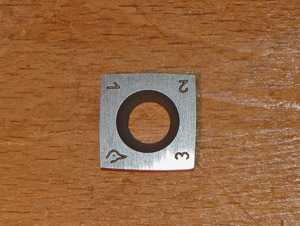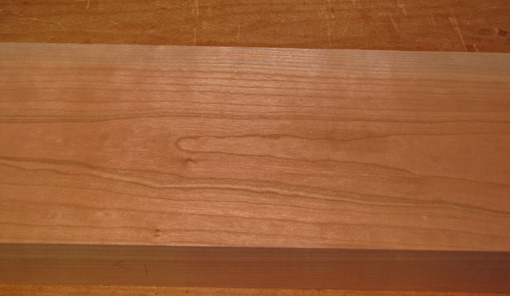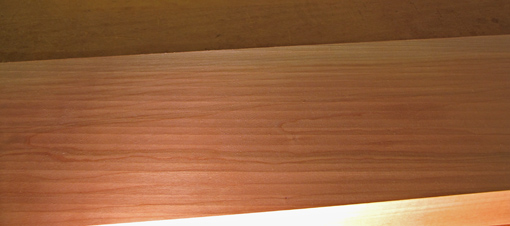
The Shelix employs three helical rows of 11 carbide cutters, arranged so that each cutter’s path is partially overlapped by other cutters. The edge of each cutter is slightly cambered (actual width of the cutter pictured above is about 5/8″) and meets the wood at an angle to the axis of the cutterhead (see below) for a shearing cut, much like skewing a handplane. Each cutter can be rotated three times to use a fresh edge when, after a long time, one has dulled. This is very different from 13 inches of blade meeting the wood all at once.

So, how does the Shelix perform? In short, beautifully. However, it produces important differences in the wood surface compared to a standard cutterhead.
The first thing I tested was the consistency of thicknessing across the width of the bed. I passed two 3/4″ wide wood strips simultaneously through the planer at each side of the bed. They came out less than 0.001″ different from each other in thickness. Wow.
The planer seems to vibrate slightly more with the Shelix but this does not seem to get translated to the bed or the wood. Noise is reduced – still loud enough for hearing protection, but not the scream produced with the OEM blades. Planing wide stock demonstrated that the Shelix gives the DW735 significantly more functional power. Dust collection improved from excellent to great, with fewer shavings sticking to the rubber rollers.
I fed this beast some nasty woods, including waterfall bubinga, curly and quilted maple, lacewood, rowed mahogany, and brittle curly pear. I took passes that I expected to be too deep and fed some wood in the wrong grain direction. The results: no tearout! The only exception was very slight on the lacewood (which hates machine blade surfacing) but much less than with the OEM blades. It laughed at the docile, straight-grained cherry in the photo below.

So, where’s the “but . . . ?” Look at the photo below, showing the same cherry board as above, but in a low, raking light. Notice the scalloped rows produced by the cambered cutters. The depth of the scallops is about 0.002″. This is different from what we’re used to with machined surfaces.

I thought at first that the scalloped surface would be a disadvantage. I wondered if referencing off such a surface would be compromised. Obviously, any machined surface is not the final one for furniture, but I wondered how this surface would clean up, and at what point in a project I would start to do so. More intriguing, could the scalloped surface have any advantages? All of these questions must be addressed to be able to integrate this new tool into the process of a woodworking project.
Next: answers to the above.


Can’t wait to find out!
Interesting test Rob, looking forward to the answers to the remaining questions. I have the DW 735, what’s the price range of the cutter head tested? The scolloped surface is a little unnerving, but I’m sure we’ll get the straight scoop (pardon the pun) from you.
Rick,
$447. It can be ordered directly from Byrd, but I can’t find it listed on their site. http://www.byrdtool.com/index.html Or it can be ordered from Holbren (same price): http://www.holbren.com/dewalt/
Rob